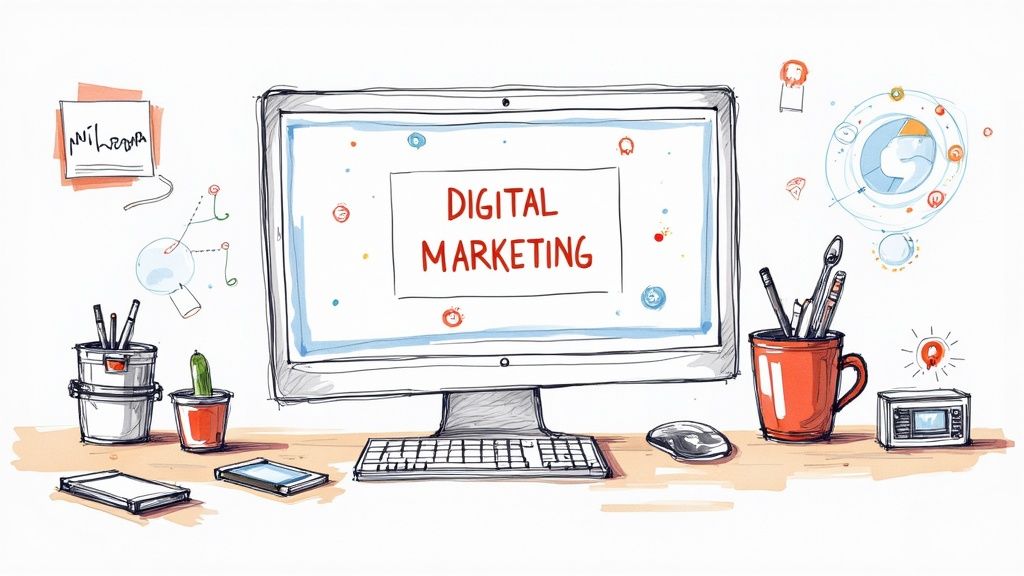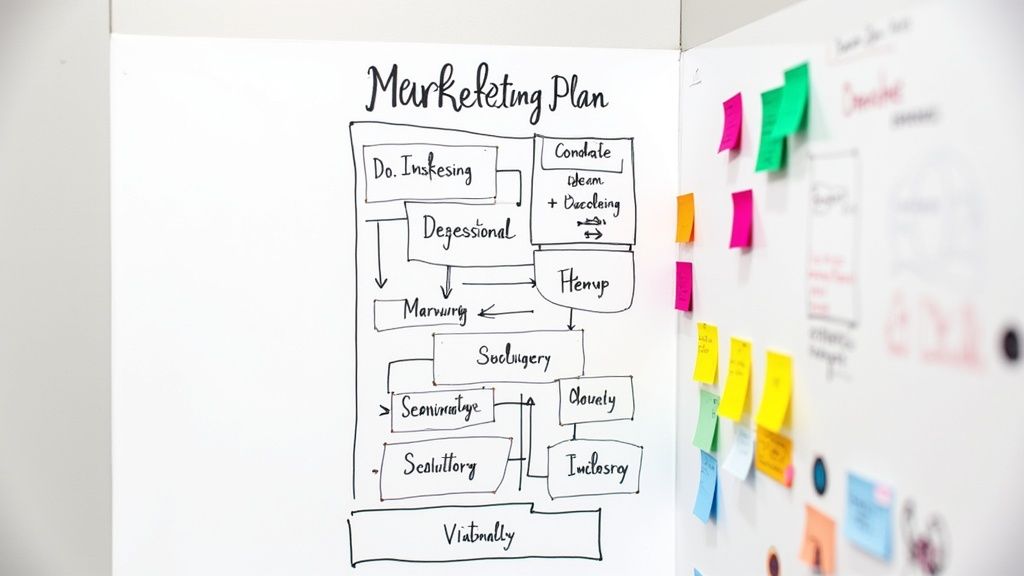10 Small Biz Marketing Strategies
Building Your Marketing Foundation: The Smart DIY Approach

Small business owners often find marketing to be an overwhelming task that feels like taking on another full-time job. Nearly half of all small business owners (47%) handle their marketing independently. But you don't need a big team or budget to market your business effectively. The key is to build a strong foundation by understanding your audience, establishing clear brand identity, and creating workable systems that deliver results.
Defining Your Target Audience and Brand
Success starts with truly knowing your ideal customer - not just their age and location, but their real needs and challenges. Take a local bakery, for example. Their ideal customer might be someone who lives nearby and cares deeply about quality ingredients and handmade goods. This insight shapes how the bakery presents itself, from highlighting locally-sourced ingredients to showcasing the skilled craftsmanship of their bakers. When you understand what matters to your customers, you can communicate your value in ways that resonate with them.
Prioritizing High-Impact Activities
When time and resources are limited, focus on marketing activities that deliver the best results. Digital channels often provide the biggest impact - it's no surprise that 58% of business owners use digital marketing to attract customers. A mobile-friendly website is especially important since 61% of visitors won't return to sites that don't work well on their phones. By concentrating on these key digital elements, you can reach more people and give them a great experience with your brand.
Leveraging the Right Tools
Many helpful tools exist to make marketing easier and more efficient. Free and low-cost options include social media schedulers to plan and track posts, and email marketing platforms to run and measure campaigns. These tools don't require advanced tech skills, making them perfect for busy business owners. They also provide helpful data about what's working, so you can keep improving your marketing approach over time.
Building Systems for Scalability
Good marketing isn't just about quick wins - it's about creating processes that grow with your business. This means writing down your procedures, making reusable templates, and setting up clear workflows. For example, using a content calendar helps you post consistently on social media, while a customer relationship management (CRM) system helps you track and nurture customer relationships. These organized systems help you market efficiently even as your customer base grows. With this practical DIY approach, you can build marketing habits that support your business's long-term growth and success.
(Emulating professional blog style):
Digital Marketing Mastery: Converting Visitors Into Customers

A strong marketing foundation is essential, but it's just the beginning. The real challenge lies in turning your online presence into a customer-generating engine. Small businesses need effective digital marketing strategies that go beyond attracting visitors - they need to convert those visitors into paying customers. Think of your online presence like a physical store: You wouldn't simply open the doors and hope for sales. Instead, you'd carefully plan the layout, showcase your best products, and train your staff to provide excellent service. Your digital presence deserves the same strategic approach.
Optimizing Your Website for Conversions
Your website should work as hard as your best salesperson. Rather than serving as a simple online brochure, it needs to actively guide visitors toward taking action. Start with search engine optimization (SEO) to help potential customers find you more easily in search results. For example, if you run a local bakery, including specific phrases like "best sourdough bread in Portland" helps connect you with nearby customers searching for exactly what you offer. But good SEO is just the start. Your site must also work well for actual humans - with easy navigation, fast loading times (especially since 61% of people won't return to slow mobile sites), and content that speaks directly to your audience's needs.
Content Marketing That Connects
Quality content forms the backbone of effective customer engagement. By creating helpful blog posts, articles, videos, and infographics that address your audience's specific needs, you build trust and establish expertise. Think of content as starting a conversation with potential customers. A local bakery might share detailed posts about sourdough benefits, favorite bread recipes, or home baking tips. This approach not only attracts new visitors but keeps them coming back for more valuable information. As an added benefit, well-crafted content naturally includes relevant keywords that support your SEO efforts, helping more potential customers find you online.
Measuring and Analyzing Your Results
Just as you'd track sales data in a physical store, monitoring your online performance reveals what's working and what needs adjustment. Use analytics tools to understand website traffic patterns, visitor behavior, and conversion rates. You might discover that certain blog posts drive significant traffic, or notice where customers abandon their shopping carts. These insights are invaluable for improving your marketing strategy and website experience. By making data-informed decisions about where to focus your efforts and resources, you can steadily improve results over time. Regular analysis and adjustment help you stay responsive to customer needs and build an online presence that turns browsers into buyers.
Social Media Success: Creating Authentic Connection

While a strong website and engaging content help convert visitors to customers, social media opens up unique ways to build real relationships that fuel business growth over time. The goal isn't chasing high follower counts - it's creating meaningful interactions that deliver actual business results. With 96% of small businesses now using social media for marketing, having an effective social strategy is essential. The key is breaking through the noise to connect with your audience in an authentic way.
Developing Content That Sparks Conversation
Success on social media comes from creating content that naturally encourages interaction. Instead of just promoting your business, share helpful tips, interesting stories, and questions that get your audience talking. For example, a local coffee shop could post videos showing how they roast their beans and invite customers to ask questions about the process. This kind of back-and-forth builds trust and helps create a real community around your brand.
Building Community Around Your Brand
Social platforms give you a perfect space to gather your biggest fans and customers. This means regularly chatting with followers, responding quickly to comments and messages, and making people feel like they truly belong. You might start a private Facebook group where customers can share experiences, or host live Instagram Q&As to connect directly. When you build genuine community, customers become your biggest supporters.
Leveraging Organic and Paid Strategies Effectively
The best social media approach combines both organic posting and paid advertising. Regular organic content and community engagement creates a foundation of trust. Meanwhile, targeted paid ads help you reach new audiences and boost important messages. For instance, you could run ads promoting a special deal to new local customers while using organic posts to stay connected with current ones. Using both strategies together helps you grow while keeping those authentic connections.
Measuring Real Social Media ROI
Being active on social media isn't enough - you need to know what's actually working. Look beyond basic metrics like followers and focus on what matters to your business: website visits from social posts, leads generated through campaigns, and sales tied to social media efforts. By tracking these key numbers, you can fine-tune your strategy, use your budget wisely, and show exactly how social media impacts your bottom line. This practical approach helps you improve results over time.
Email Marketing Excellence: Your Secret Revenue Engine

While social media helps build relationships with your audience, converting those connections into sales often requires more direct communication. Email marketing consistently proves its worth as a reliable revenue driver, with data showing an exceptional return on investment compared to other marketing channels. The numbers speak for themselves - 64.1% of small businesses rely on email marketing because it works. Let's explore how to build and optimize an email list that becomes a valuable business asset.
Building a High-Quality Email List
Creating an effective email list starts with attracting the right subscribers - people who genuinely want to hear from you and are interested in what you offer. Make it worth their while by providing real value upfront. For example, a local bakery might share an exclusive recipe collection in exchange for email signups. Keep the subscription process simple by only asking for essential details like name and email. This reduces friction and encourages more people to join your list.
Segmentation: The Key to Personalized Messaging
Sending the same message to everyone rarely works well - just like a generic flyer wouldn't appeal to an entire town. Break your email list into smaller groups based on what you know about your subscribers' interests, past purchases, and preferences. That same bakery could create separate segments for bread enthusiasts, gluten-free customers, and cake buyers. This allows for more relevant, targeted messages that drive better results because they speak directly to what each group cares about.
Automation: Working Smarter, Not Harder
With your list properly segmented, email automation helps you send the right messages at the right time without constant manual work. Set up welcome sequences for new subscribers and follow-up emails after purchases. The bakery could automatically send a series of sourdough baking tips to someone who downloads their bread recipe guide. These timely, relevant messages keep customers engaged while saving you time and effort.
Content That Keeps Subscribers Engaged
Even with perfect segmentation and automation, your success still depends on sending content people actually want to read. Mix helpful information with occasional promotions - don't just sell. Share expert tips, give behind-the-scenes peeks at your business, or spotlight customer stories. Our bakery example could include seasonal baking guides, ingredient spotlights, and photos of customers' successful recipes. This variety keeps subscribers opening your emails and positions you as a trusted resource they want to hear from. With consistent testing and refinement of your approach, your email list becomes an increasingly valuable channel for growing your business.
Smart Marketing Investment: Maximizing Limited Resources
Every small business faces the challenge of making their marketing budget work harder. Success comes from being strategic about where and how you invest your limited marketing dollars. By focusing on activities that deliver real results and measuring what works, you can grow your business without overspending.
Identifying High-ROI Marketing Opportunities
The key is finding marketing channels that truly connect with your target customers. Think about where your audience spends their time - for a younger demographic, social media campaigns often deliver better results than traditional print ads. Look at your website analytics, track which social posts get the most engagement, and listen to customer feedback. This helps you spot which marketing activities are worth your investment and which ones aren't pulling their weight.
Strategic Partnerships: Amplifying Your Reach
Working together with complementary businesses can help you reach more customers without spending more money. For example, a local coffee shop might team up with a bookstore nearby - their customers grab a coffee while browsing books, and both businesses benefit. These partnerships could involve running joint events, creating special combo deals, or cross-promoting each other's services. The trick is finding partners who share your target market but don't compete directly.
Content Systems: Delivering Consistent Results
Regular, valuable content helps keep customers coming back, but you don't need to start from scratch every time. Set up a simple system to create content efficiently. One blog post about small business marketing tips could become several social media posts, an email newsletter section, and quick video tips. This approach helps you create steady content that keeps your audience engaged while saving time and effort.
Measuring and Optimizing Marketing Spend
Keep close track of how your marketing efforts perform. Use basic analytics tools to see which website pages get traffic, which emails get opened, and which social posts drive engagement. If your Facebook ads aren't bringing in leads, try adjusting your targeting or testing different messages. Regular monitoring helps you spot what's working and what isn't, so you can put more resources into your most effective marketing channels and improve your return on investment.
Future-Ready Marketing: Building Sustainable Growth
Running a successful small business means keeping up with current marketing trends while being ready for what's next. Building a resilient marketing foundation helps protect your business from market changes and new technologies.
Embracing Emerging Trends and Technologies
Changes in the marketing landscape never stop. The rise of new social media and tech tools keeps creating fresh ways to connect with customers. Being on top of these shifts is essential. Take short-form video for example - platforms like TikTok and Instagram Reels have transformed how brands engage audiences. Small businesses that jumped in early with creative video content found entirely new customer groups. Staying alert and responsive to emerging trends like this one is key.
Testing New Channels and Integrating Innovative Tools
Growth comes through smart experimentation. Try out promising new marketing approaches while keeping what already works. For instance, you might explore partnering with relevant influencers or creating interactive content - but don't drop effective channels like email marketing. The goal is finding the right mix. New additions should improve your current strategy, not replace it entirely. Test thoughtfully and measure results to find what truly moves your business forward.
Scaling Your Marketing Efforts for Growth
As your business gets bigger, your marketing needs to grow with it. The strategies that served you well as a startup may not fit once you have more customers and resources. Put systems in place that can expand smoothly. For example, use marketing automation tools to handle larger email lists without losing the personal touch. Pick a solid customer relationship management (CRM) system that helps you stay connected with a growing client base. Make sure you're putting resources into the channels showing the best results.
Adapting to Market Changes and Maintaining Competitive Advantage
Markets shift constantly due to economic changes, evolving customer needs, and fresh competition. Being ready for the future means staying flexible and alert. Create clear processes for spotting opportunities, assessing risks, and adjusting course when needed. Keep a close eye on your data and industry trends. Really listen to what your customers want. This helps you adapt quickly while staying ahead of competitors. Building a business that lasts requires accepting and planning for ongoing change.
Boost your customer engagement and streamline your support with Sitebot's custom AI chatbots. Built with GPT-4, Sitebot allows you to create multilingual chatbots tailored to your specific business needs. Integrate seamlessly with your website and other platforms like Slack and Zendesk. Gain valuable insights with advanced analytics and watch your business grow. Start your free trial today at https://sitebot.co!


